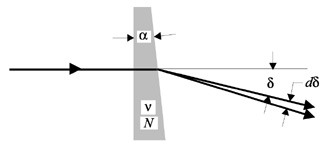Optipedia • SPIE Press books opened for your reference.
Wedge (Thin Prism)
Excerpt from Optical Design Fundamentals for Infrared Systems, Second Edition
Two flat surfaces, slightly out of parallel to each other, form a wedge. Applying Snell's law in determining the direction a ray will take after passing through the wedge, and assuming that the wedge angle is small, we find the deviation from the entering ray direction to be

The dispersion is

where

All other symbols are shown in Fig. 1.

Figure 1 Deviation and dispersion of a thin prism (wedge).
A useful combination of lens plus wedge, as shown in Fig. 2, has been applied by the author in a simple two-color discriminator. Two wedges installed behind a common singlet, shaped for minimum spherical aberration, provide a cost-effective method to split the aperture and create two subsystems, each working in a specific spectral band. The wedges serve as filter substrates and redirect the focused energies for clear separation, yet are close enough so that the two detector elements of different chemistry can be installed into a single hermetically sealed standard detector housing.

Figure 2 A two-color discriminator optical system.
M. Riedl, Optical Design Fundamentals for Infrared Systems, Second Edition, SPIE Press, Bellingham, WA (2001).
View SPIE terms of use.
Non-Member: $58.00

